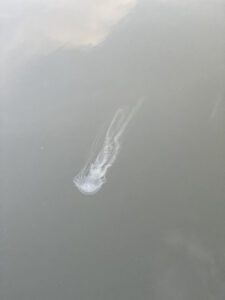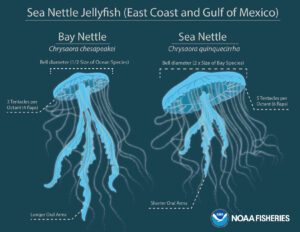Issue 1 | September 2021 | Don’t Be Nettled!

By Bryan Kent Gomes
It’s late summer, it’s hot outside, and you want to go for a dip in the Bay or local river. You get ready to jump in and then you see … is that a fish? a plastic bag? Wait, is that – a sea nettle? Atlantic sea nettles or jellyfish as we call them colloquially, are an umbrella shaped invertebrate that are free swimming and produce a sting that can cause moderate discomfort.
 The sea nettle has a somewhat transparent jelly-like body with a big bell or dome top. It has a mouth located at the center of one end of the body which opens to a stomach-like cavity that is used for digestion. It has stinging cells, called nematocysts, in their tentacles that surround the mouth to capture food. They generally feed on zooplankton, other jellies and even small crustaceans. Sea nettles immobilize their prey using their stinging tentacles. After that, the prey is transported to the stomach where it is then digested. Animals that prey on nettles include fish, crustaceans like crabs and aquatic turtles.
The sea nettle has a somewhat transparent jelly-like body with a big bell or dome top. It has a mouth located at the center of one end of the body which opens to a stomach-like cavity that is used for digestion. It has stinging cells, called nematocysts, in their tentacles that surround the mouth to capture food. They generally feed on zooplankton, other jellies and even small crustaceans. Sea nettles immobilize their prey using their stinging tentacles. After that, the prey is transported to the stomach where it is then digested. Animals that prey on nettles include fish, crustaceans like crabs and aquatic turtles.
According to scientific research, the nettles we see in our Chesapeake Bay watershed are actually a different species from those found in the Atlantic Ocean.  The Bay Nettle, Chrysora chesapeakei, has a few different identifiers that distinguish it from its more ocean-going cousin, Chrysaora quinquechirrha. Our Bay nettle has a bell/dome diameter half that of the Sea nettle as well as longer oral arms (these hang down in the middle below its mouth) and have four flaps with only three tentacles per octant where the Sea nettle has six flaps with five tentacles per octant. The shorter, more tentacle-packed Sea nettle is more adapted to the rougher and open conditions it faces in the ocean.
The Bay Nettle, Chrysora chesapeakei, has a few different identifiers that distinguish it from its more ocean-going cousin, Chrysaora quinquechirrha. Our Bay nettle has a bell/dome diameter half that of the Sea nettle as well as longer oral arms (these hang down in the middle below its mouth) and have four flaps with only three tentacles per octant where the Sea nettle has six flaps with five tentacles per octant. The shorter, more tentacle-packed Sea nettle is more adapted to the rougher and open conditions it faces in the ocean.
Our Bay nettles geographic range is dependent on salinity levels in the Bay. When we have higher salinity – usually when there are drought periods from a lack of rain that increase salinity – the nettles are able to better survive in these conditions and follow the salinity levels further north up the Chesapeake. Some summers they are found all the way up into Baltimore’s inner harbor off of the Patapsco River. Although they are slow moving, jellyfish do propel themselves through the water and are efficient swimmers. The jellyfish swims by contracting and relaxing the muscles around its dome/bell. Their mouth opens and closes, drawing water into the main body cavity that it uses to slowly and rhythmically propel itself through the water.
So what can you do if you get stung by a nettle or other jellyfish? You can start with a sea water rinse and then, if available, use baking soda to neutralize the nematocysts. If you don’t have baking soda, you can just use a credit card or piece of plastic to scrape the skin surface to further remove stinging cells. Lastly, you can take a pain reliever (Advil or Tylenol) and, if still itching or swelling, use a hydrocortisone cream on the sting three times daily. Do not use vinegar, rubbing alcohol, fresh water or scrub or rub the area – all of these can trigger the stingers!
Want to be mesmerized by jellyfish on the move? Check out the National Aquarium in Baltimore’s page with their 24 hour Jellyfish Cam! https://aqua.org/explore/exhibits/jellies-invasion
Stay tuned for another interesting “creature we feature” in our next newsletter.
Have an interesting critter we should look into? Send us an email on it and what you want to know more about?

